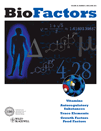
BIOFACTORS
Scope & Guideline
Elevating Research Standards in Biochemistry and Medicine
Introduction
Aims and Scopes
- Bioactive Compounds and Their Mechanisms:
Research on the mechanisms of action of various bioactive compounds, including phytochemicals, vitamins, and other natural products, and their roles in health and disease. - Cancer Biology and Therapeutics:
Studies exploring the molecular pathways involved in cancer progression, resistance mechanisms, and the potential of bioactive compounds as therapeutic agents. - Metabolic and Endocrine Disorders:
Investigations into the effects of bioactive substances on metabolic syndromes, obesity, diabetes, and related endocrine disorders. - Neurobiology and Neurodegenerative Diseases:
Research focused on the neuroprotective effects of various compounds and their roles in neurodegenerative diseases such as Alzheimer's and Parkinson's. - Inflammation and Immunomodulation:
Exploring the roles of bioactive compounds in modulating inflammatory responses and their therapeutic implications in chronic diseases. - Microbiome and Gut Health:
Studies examining the interactions between dietary components, gut microbiota, and their influence on overall health and disease outcomes. - Oxidative Stress and Antioxidant Defense:
Research on the role of oxidative stress in disease processes and the therapeutic potential of antioxidants derived from natural sources. - Molecular and Cellular Biology:
Investigations into cellular signaling pathways, gene expression, and the role of non-coding RNAs in various biological processes.
Trending and Emerging
- Personalized Nutrition and Metabolism:
An increasing focus on how individual variations in metabolism affect responses to dietary bioactive compounds, leading to personalized nutrition strategies. - Nanotechnology in Drug Delivery:
Emerging research on the use of nanotechnology to enhance the delivery and efficacy of bioactive compounds in therapeutic applications. - Gut-Brain Axis:
Growing interest in the interactions between gut microbiota and neurological health, highlighting the role of dietary components in influencing brain function. - Plant-Derived Compounds in Chronic Disease Management:
A rising trend in exploring the therapeutic potential of plant-derived compounds in managing chronic diseases such as diabetes, cardiovascular diseases, and cancer. - Immunotherapy and Bioactive Compounds:
Increased exploration of the role of bioactive compounds in enhancing immunotherapeutic approaches for cancer and other diseases. - Epigenetics and Bioactive Compounds:
Emerging research on how bioactive compounds can influence epigenetic mechanisms, potentially affecting gene expression and disease outcomes. - Sustainability and Bioactive Compounds:
A growing emphasis on sustainable sourcing and the environmental impact of bioactive compounds, reflecting a broader trend towards environmentally conscious research.
Declining or Waning
- Traditional Herbal Medicine:
There has been a noticeable decrease in publications focused on traditional herbal medicines and their applications, which may reflect a shift towards more mechanistic and targeted studies involving specific bioactive compounds. - Basic Biochemical Pathways:
Research focusing solely on basic biochemical pathways without direct relevance to health outcomes or therapeutic implications seems to be less frequent, indicating a trend towards more applied research. - Animal Models of Disease:
While animal studies remain vital, there is a waning interest in certain animal model studies, particularly those that do not translate directly to human health or therapeutic strategies. - Epidemiological Studies:
Epidemiological research examining population-level health outcomes related to bioactive compounds appears to be less emphasized in recent issues, possibly overshadowed by more mechanistic studies.
Similar Journals
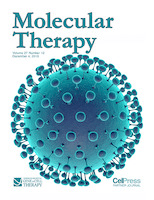
MOLECULAR THERAPY
Exploring the frontiers of molecular biology and therapy.MOLECULAR THERAPY, published by CELL PRESS, is a distinguished journal in the field of molecular biology and therapy, renowned for its significant contributions to drug discovery, genetics, and pharmacology since its inception in 2000. This prestigious journal, which holds a commendable position in the Q1 category across multiple disciplines including Drug Discovery, Molecular Medicine, and Molecular Biology, facilitates cutting-edge research and innovative therapies that aim to improve patient outcomes. With an impressive Scopus ranking that places it among the top journals in its field—such as rank #6 in Drug Discovery and #8 in Pharmacology—MOLECULAR THERAPY is crucial for researchers, professionals, and students seeking to advance their understanding and application of molecular techniques. The journal welcomes high-quality submissions that explore the therapeutic potential of molecular mechanisms, fostering a collaborative spirit within the scientific community to push the boundaries of modern medicine.
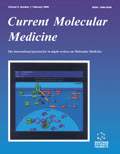
CURRENT MOLECULAR MEDICINE
Pioneering Interdisciplinary Research in Molecular MedicineCURRENT MOLECULAR MEDICINE is a pivotal journal fostering advancements in the interdisciplinary fields of molecular medicine, biochemistry, and genetics. Published by Bentham Science Publishers, this esteemed journal has been disseminating vital research findings since its inception in 2001 and is continuously dedicated to exploring the molecular basis of health and disease. With a focus on translational research, CURRENT MOLECULAR MEDICINE provides an invaluable platform for researchers, healthcare professionals, and students, making significant contributions to the understanding of molecular mechanisms and therapeutic strategies. With an ISSN of 1566-5240 and an E-ISSN of 1875-5666, the journal holds a commendable position within the scientific community, being ranked Q3 in Biochemistry and Molecular Biology and Q2 in Medicine (miscellaneous) as of 2023. This journal does not currently operate on an open access model but remains accessible through various institutional subscriptions. The multidisciplinary scope covering molecular biology to medicinal applications positions CURRENT MOLECULAR MEDICINE as an essential resource for those striving to meet the challenges of modern healthcare and biomedical research.

STRESS-THE INTERNATIONAL JOURNAL ON THE BIOLOGY OF STRESS
Exploring the Complexities of Stress BiologySTRESS - THE INTERNATIONAL JOURNAL ON THE BIOLOGY OF STRESS, published by Taylor & Francis Ltd, is an esteemed open-access journal dedicated to advancing our understanding of stress and its biological underpinnings. Established in 1996 and continuing until 2024, this journal is pivotal in the exploration of stress across multiple dimensions, including its impact on mental health, neurobiology, and endocrine systems. With an impressive categorization in Q2 and Q3 quartiles across various fields such as Behavioral Neuroscience, Psychiatry, and Physiology, STRESS ranks commendably within its discipline, positioning itself as a vital resource for researchers and professionals alike. As of 2022, the journal's open access policy enhances visibility and accessibility, fostering a broader dissemination of knowledge. The journal invites submissions from a diverse range of disciplines, aiming to bridge gaps across fields and encourage interdisciplinary collaboration. By addressing the multifaceted nature of stress, STRESS remains essential for those eager to contribute to this dynamic and critical area of research.
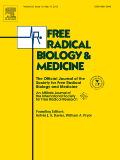
FREE RADICAL BIOLOGY AND MEDICINE
Advancing Knowledge in Biochemistry and Medical PhysiologyFREE RADICAL BIOLOGY AND MEDICINE, published by Elsevier Science Inc, is a premier journal dedicated to the field of biochemistry and medical physiology. With an ISSN of 0891-5849 and an E-ISSN of 1873-4596, this journal stands out with its impressive ranking in the 2023 category quartiles: Q1 in Biochemistry and Q1 in Physiology (medical). Specifically, it has achieved a remarkable position of 29th out of 438 in Biochemistry and 8th out of 113 in Physiology, placing it firmly in the 93rd percentile of its field, as per Scopus rankings. Since its inception in 1987, the journal has focused on advancing the understanding of free radicals and their role in biological processes, encompassing a wide range of topics from oxidative stress to therapeutic applications. Although it does not currently offer open access, the journal's rigorous peer-review process and impactful research ensure that it remains a valuable resource for researchers and professionals seeking to explore the intricate relationships between free radicals and health. The journal's headquarters are located at STE 800, 230 Park Ave, New York, NY 10169, reflecting its esteemed place within the scientific community and commitment to high-quality research.

REDOX REPORT
Bridging Research and Clinical InnovationREDOX REPORT is a peer-reviewed academic journal published by Taylor & Francis Ltd, focusing on the latest advancements in the fields of biochemistry, clinical biochemistry, and physiology. Since its inception in 1996 and transitioning to an Open Access model in 2018, this journal has aimed to disseminate high-quality research findings and foster discussions within the scientific community. Positioned in the Q2 quartile across several relevant categories, including Biochemistry, Cell Biology, and Clinical Biochemistry, REDOX REPORT is recognized for its commitment to impactful research. The journal plays a crucial role in bridging the gap between fundamental biochemical research and its clinical applications, making it an essential resource for researchers, professionals, and students alike. With a consistent publication record extending to 2024, REDOX REPORT is dedicated to featuring cutting-edge studies that advance our understanding of redox biology, thereby contributing significantly to the ongoing dialogue in the life sciences.

METABOLIC BRAIN DISEASE
Illuminating pathways to better neurological outcomes.METABOLIC BRAIN DISEASE, published by SPRINGER/PLENUM PUBLISHERS, is a leading journal dedicated to advancing our understanding of the metabolic processes impacting brain health and disease. Established in 1986 and set to continue until 2024, this journal encompasses a wide range of interdisciplinary research that intersects the fields of Biochemistry, Cellular and Molecular Neuroscience, and Neurology, as evidenced by its notable quartile placements in Q2 and Q3 for 2023. With an ISSN of 0885-7490 and an E-ISSN of 1573-7365, it serves as a vital resource for researchers and practitioners aiming to deepen their insights into cerebral metabolic disorders and their implications. Although currently not an Open Access option, its rigorous peer-review process ensures that high-quality, impactful research reaches its audience. Showcasing a significant rank within the top percentile of its categories, METABOLIC BRAIN DISEASE is instrumental in shaping the future of neurological research and clinical applications.
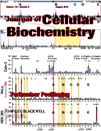
JOURNAL OF CELLULAR BIOCHEMISTRY
Advancing the Frontiers of Biochemical ResearchJournal of Cellular Biochemistry is a premier academic journal dedicated to advancing the field of biochemistry and cellular biology. Published by Wiley, this influential journal has a significant impact factor that underscores its relevance and authority within the scientific community. With its ISSN 0730-2312 and E-ISSN 1097-4644, the journal has been on the frontier of research since its inception in 1982, and is expected to continue publishing cutting-edge studies through 2024. As evidenced by its ranking in the 2023 Scopus Quartiles, it holds a rank of Q2 in Biochemistry and Q3 in both Cell and Molecular Biology, placing it among the top tiers of scientific journals in these disciplines. The Journal of Cellular Biochemistry serves as a vital resource for researchers, professionals, and students alike, providing a platform for the dissemination of innovative ideas and findings that shape our understanding of cellular processes and biochemical pathways. Though it does not currently offer Open Access options, its robust peer-review process ensures that each publication meets the highest academic standards, thus solidifying its esteemed position in the landscape of biochemical research.

JOURNAL OF PHYSIOLOGY AND BIOCHEMISTRY
Illuminating Pathways in Biochemistry and PhysiologyJOURNAL OF PHYSIOLOGY AND BIOCHEMISTRY, published by Springer in the Netherlands, serves as a pivotal platform for disseminating high-quality research within the fields of physiology, biochemistry, and related biomedical sciences. With an impressive impact factor reflected in its categorization as Q2 in Biochemistry and Q1 in Medicine (miscellaneous), this journal fosters a vibrant community of scholars dedicated to advancing knowledge and innovation. The journal’s broad scope encompasses a wide range of topics from cellular mechanisms to systemic physiology, making it relevant for both theoretical and applied sciences. Researchers and practitioners are encouraged to utilize the available Open Access options to reach a wider audience. The journal’s continuous contribution to the scientific dialogue since its inception in 1996 positions it as a key resource for professionals and students alike, facilitating the exploration of cutting-edge topics and collaborative research opportunities.

JOURNAL OF MOLECULAR MEDICINE-JMM
Elevating the Standards of Molecular Medicine Research.JOURNAL OF MOLECULAR MEDICINE (JMM) is a premier publication dedicated to advancing the field of molecular medicine, encompassing critical areas such as drug discovery, genetics, and biochemistry. Published by Springer Heidelberg in Germany, this influential journal has established its significance within the academic community, achieving an impressive Q1 ranking across multiple categories as of 2023, including Drug Discovery, Clinical Genetics, and Molecular Medicine. With a focus on publishing high-quality research and novel insights, JMM appeals to a diverse audience of researchers, professionals, and students passionate about the molecular underpinnings of health and disease. The journal, which has seen a convergence of relevant research spanning from 1976 to 2024, is instrumental in showcasing groundbreaking studies that push the boundaries of knowledge in molecular therapeutics and biomedical science. While it does not offer open access, the rigor of its peer-reviewed content ensures that each publication is a valuable addition to the scientific discourse surrounding molecular medicine. For comprehensive studies and reviews that highlight the intersection of molecular biology and clinical application, look no further than JOURNAL OF MOLECULAR MEDICINE.

INTERNATIONAL JOURNAL OF BIOCHEMISTRY & CELL BIOLOGY
Advancing the Frontiers of Biochemistry and Cell BiologyThe International Journal of Biochemistry & Cell Biology, published by Pergamon-Elsevier Science Ltd, stands as a pivotal resource in the fields of biochemistry and cell biology. With an ISSN of 1357-2725 and an E-ISSN of 1878-5875, this prestigious journal has been a key platform for disseminating cutting-edge research since its inception in 1995. The journal currently holds an impressive Q1 ranking in Biochemistry and a Q2 ranking in Cell Biology for the year 2023, reflecting its commitment to high-quality research and its influence within the scientific community. With a significant Scopus ranking of 94/438 in Biochemistry and 96/285 in Cell Biology, the journal plays a crucial role in advancing knowledge and fostering innovative approaches in these dynamic fields. Though it is not an open-access journal, the International Journal of Biochemistry & Cell Biology remains accessible to a wide audience, making it a vital resource for researchers, professionals, and students alike, who are eager to explore and contribute to the ongoing advancements in biochemistry and cell biology.